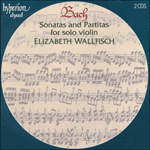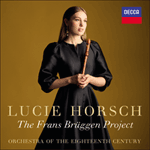The Partita in E major (BWV1006) is, perhaps the most readily accessible of the six works for unaccompanied violin. It begins with a dashing, bravura Preludio whose almost unbroken pattern of semiquavers, together with passages of ‘bariolage’ and its bright key of E major, imbue the piece with radiance and anticipatory excitement. Bach himself must have thought especially well of this movement since, nine years later, in 1729, he transcribed the violin part for organ, adding parts for strings, oboes and basso continuo to create a sinfonia for a wedding cantata (BWV120a). Two years later, he turned to the piece again, further expanding the orchestration to include trumpets and drums, this time to provide an introduction to a cantata (BWV29) for the installation of the Leipzig city council in 1731. In the remaining movements Bach resisted the conventional sequence of dances belonging to the classical suite, confining himself to ‘galanteries’. After a Loure, a movement of gigue-like character but with a more intricate rhythm, follows a catchy Gavotte en rondeau. The first of two Menuets yields an air of courtly refinement while the second, with its tied ‘drone’ minims is of a more pastoral character. The syncopated Bourrée derives engaging effects from Bach’s carefully marked dynamic contrasts, while an airy, sprightly Gigue brings the Partita to a warmly expressive and convivial conclusion.
from notes by Nicholas Anderson © 2009
La Partita en mi majeur (BWV1006) est peut-être la plus facile d’accès parmi les six œuvres pour violon seul. Elle commence par un superbe Preludio de bravoure où l’enchaînement presque ininterrompu de doubles croches, comme les passages de bariolage et la brillante tonalité de mi majeur imprègnent cette pièce de rayonnement et d’excitation par anticipation. Bach lui-même devait particulièrement apprécier ce mouvement car, neuf ans plus tard, en 1729, il a transcrit la partie de violon pour orgue, en ajoutant des parties de cordes, hautbois et basse continue afin de créer une sinfonia pour une cantate de mariage (BWV120a). Deux ans plus tard, il est revenu à nouveau vers ce morceau pour en élargir l’orchestration en ajoutant des trompettes et des timbales, cette fois comme introduction à une cantate (BWV29) pour l’installation du conseil municipal de Leipzig en 1731. Dans les autres mouvements, Bach a résisté à la séquence conventionnelle de danses de la suite classique et s’est confiné à des galanteries. Après une Loure, mouvement comparable à une gigue mais au rythme plus complexe, vient une entraînante Gavotte en rondeau. Le premier des deux Menuets a un air de raffinement courtois, alors que le second, avec ses blanches liées qui produisent un effet de bourdon, est d’un caractère plus pastoral. La Bourrée syncopée tire des effets intéressants des contrastes dynamiques soigneusement marqués de Bach, alors qu’une Gigue insouciante et alerte amène la partita à une conclusion chaleureusement expressive et conviviale.
extrait des notes rédigées par Nicholas Anderson © 2009
Français: Marie-Stella Pâris
Die Partita in E-Dur (BWV 1006) ist möglicherweise das am besten zugängliche Werk des Zyklus. Es beginnt mit einem kühnen und bravourösen Preludio, dessen fast ununterbrochene Sechzehntelbewegung und „Bariolage“-Passagen in leuchtendem E-Dur dem Stück ein Strahlen und eine angespannte Erwartungshaltung verleihen. Bach selbst muss dieser Satz besonders gut gefallen haben, da er 1729, neun Jahre später, die Violinstimme für Orgel umschrieb und Stimmen für Streicher, Oboen und Basso continuo hinzufügte und das Ganze als Sinfonia für eine Hochzeitskantate (BWV 120a) verwendete. Zwei Jahre später kehrte er wiederum zu dem Stück zurück und dehnte diesmal die Orchestrierung noch weiter aus, indem er Trommeln und Trompeten hinzufügte und damit die Einleitung zur Kantate BWV 29 für die Ratswahl in Leipzig 1731 anfertigte. In den verbleibenden Sätzen richtete Bach sich nicht nach der konventionellen Abfolge von Tänzen in einer klassischen Suite, sondern beschränkte sich stattdessen auf „Galanterien“. Auf eine Loure, ein Satz, der im Charakter an die Gigue erinnert, jedoch einen komplexeren Rhythmus hat, folgt eine eingängige Gavotte en rondeau. Das erste der beiden Menuette erzeugt eine Atmosphäre höfischer Kultiviertheit, während das zweite mit seinen gebundenen Halben im Bass einen eher pastoralen Charakter hat. Die synkopierte Bourrée erhält durch die von Bach genau angegebenen dynamischen Kontraste einen gefälligen Charakter, während eine anmutige, heitere Gigue die Partita zu einem warmen, ausdrucksvollen und fröhlichen Ende bringt.
aus dem Begleittext von Nicholas Anderson © 2009
Deutsch: Viola Scheffel


 Bach: Sonatas and Partitas for solo violin
Bach: Sonatas and Partitas for solo violin The Frans Brüggen Project
The Frans Brüggen Project
